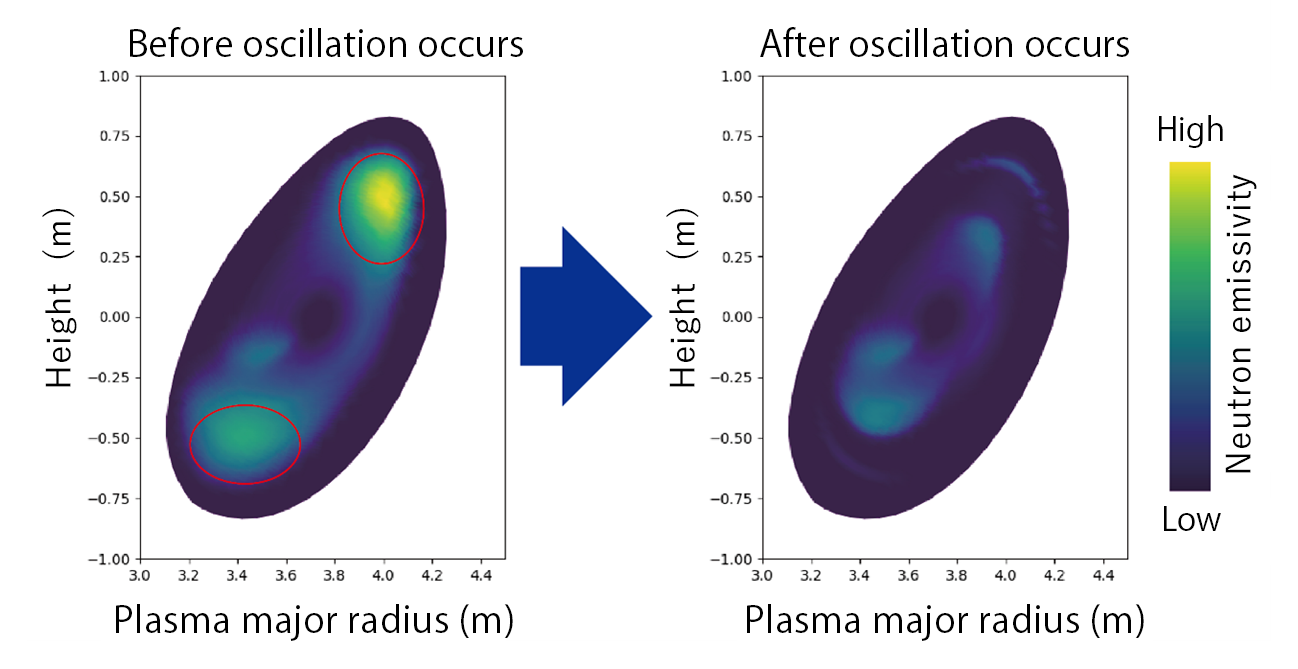Investigating the cause of the disturbance in maintaining the high-ion temperature state
In high-ion temperature plasma discharges in the Large Helical Devices, magnetic field oscillations, caused by energetic ions, limit the sustainment of high-ion temperature state. In this study, the energetic ions escaping from the plasma due to the magnetic field oscillation has been observed by the neutron emission profile diagnostics in a deuterium plasma experiment. Based on this result, it is expected to develop a method to maintain a high-ion temperature state for a long time.

The Large Helical Device (LHD) has achieved ion temperatures above 120 million degrees Celsius. In high-ion temperature plasma discharges, magnetic field oscillations, generated by the pressure of the energetic ions, occur frequently. In high-ion temperature plasma discharges, the magnetic field oscillations limit the sustainment of the high-ion temperature state. In order to investigate the relationship between the magnetic field oscillation and the decrease in ion temperature, we experimented with obtaining the spatial distribution of energetic ions in a plasma discharge with a magnetic field oscillation.
This research team obtained the spatial distribution of energetic ions by measuring the emission distribution of a small number of neutrons, which are mainly produced by a fusion reaction between energetic ions and main plasma ions. The neutron emission profile diagnostics consist of a neutron detector with many sightlines, which was developed and constructed by this research team using cutting-edge digital circuit technology. By comparing the neutron emission profiles before and after the onset of the magnetic field oscillation, it was found that the number of neutrons generated in the line of sight,looking at a specific location in the plasma,was greatly reduced. In addition, the relationship between the magnitude of the magnetic field oscillation and the decrease in energetic ions was investigated, and it was found that the decrease in energetic ions was proportional to the magnitude of the magnetic field oscillation.
In this study, we further investigated in detail how neutron production distribution changes when magnetic field oscillations occur by using orbit-following numerical simulations of energetic ions. The large decrease in neutron production at a particular plasma location observed in the experiment was found to correspond to the escape of energetic ions from the plasma during the magnetic oscillation. This result greatly advances our understanding of the relationship between magnetic field oscillations and confinement of energetic ions heating the plasma, and provides important insights into how to maintain a high-ion temperature state in LHD plasmas for a long time.
This research was carried out by a research group led by Kunihiro Ogawa and Mitsutaka Isobe at the National Institute for Fusion Science, in collaboration with Associate Professor Hideaki Matsuura at Kyushu University and Dr. D.A. Spong at Oak Ridge National Laboratory, USA.
The research results were selected as an invited talk at The 16th Technical Meeting on Energetic Particles in Magnetic Confinement Systems — Theory of Plasma Instabilities and published in Nuclear Fusion, a journal on controlled thermonuclear fusion by the International Atomic Energy Agency on August 27, 2020.
